|
Strain Name
|
C57BL/6-TFR1tm1(TFR1)Bcgen Slc3a2tm1(SLC3A2)Bcgen/Bcgen
|
Common Name
|
B-hTFR1/hCD98HC mice
|
|
Background
|
C57BL/6
|
Catalog number
|
113596
|
Related Genes
|
GPR73L1, GPR73b, GPRg2, HH3, KAL3, PKR2, dJ680N4.3
|
NCBI Gene ID
|
7037; 6520
|
Description
Background:
-
TFR1, a membrane protein expressed across various cell and tissue types in the human body, plays a crucial role in facilitating iron transport and metabolism. TFR1 is markedly expressed in numerous types of cancer cells. Studies have demonstrated that targeting TFR1 can effectively suppress tumor growth and metastasis. Moreover, TFR1 is also implicated in other conditions such as anemia and neurodegenerative disorders, etc.
-
CD98HC (also known as SLC3A2) plays a crucial role in maintaining the integrity of the blood-brain barrier (BBB) and in nutrient transport, including amino acid transport, integrin signaling, and cellular stress responses.
-
Given its high expression of TFR1 and CD98HC on brain endothelial cells, TFR1 and/or CD98HC can be leveraged as a receptor for receptor-mediated transcytosis (RMT), which allows for the efficient transport of large molecules across the BBB. This makes it an ideal target for delivering biotherapeutics to the central nervous system (CNS).
Target strategy:
-
The genome of mouse Tfr1 gene that encode the extracellular domain were replaced by human TfR1 counterparts in B-hTFR1 mice.
-
The exons 2-10 of mouse Cd98 gene that encode the extracellular domain were replaced by human CD98 exons 4-12 in B-hCD98HC mice.
-
B-hTFR1/hCD98HC mice were obtained by mating B-hTFR1 mice (110861) and B-hCD98HC mice (110983).
Verification:
-
Human TFR1 protein and CD98HC protein were exclusively detectable in B-hTFR1/hCD98HC mice but not in wild-type mice. Humanization of TFR1 and CD98HC did not change the overall frequency or distribution of immune cell types in spleen, blood and lymph nodes.
Application:
-
This product is used to evaluate the pharmacodynamics and safety of treatments for tumors and neurodegenerative diseases, as well as to assess the potential of drugs to penetrate the blood-brain barrier.
Targeting strategy
Gene targeting strategy for B-hTFR1/hCD98HC mice. The exons 4-19 of mouse Tfr1 gene that encode extracellular domain are replaced by human counterparts in B-hTFR1 mice. The genomic region of mouse Tfr1 gene that encodes cytoplasmic portion is retained. The promoter, 5’UTR and 3’UTR region of the mouse gene are also retained. The chimeric TFR1 expression is driven by endogenous mouse Tfr1 promoter, while mouse Tfr1 gene transcription and translation will be disrupted.
The exons 2-10 of mouse Cd98 gene that encode the extracellular domain were replaced by human CD98 exons 4-12 in B-hCD98HC mice.
B-hTFR1/hCD98HC mice were obtained by mating B-hTFR1 mice (110861) and B-hCD98HC mice (110983).
Protein expression analysis of TFR1 in BM erythrocytes
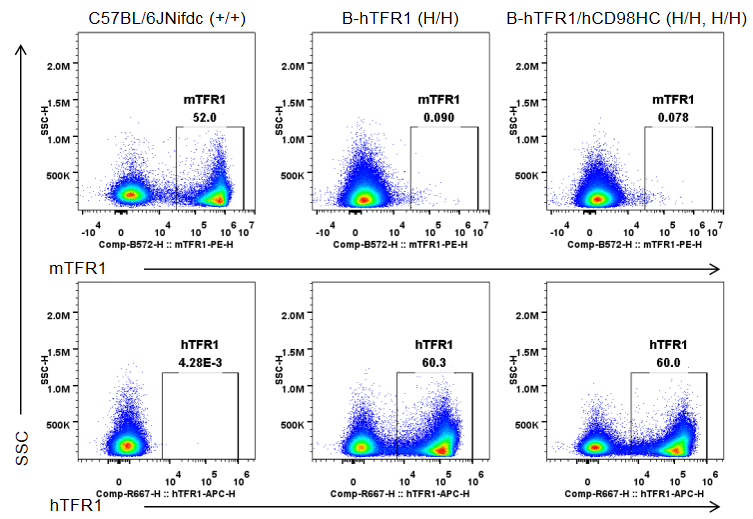
Strain specific TFR1 expression analysis in wild-type C57BL/6JNifdc and homozygous B-hTFR1/hCD98HC mice by flow cytometry. Bone marrow cells were collected from wild-type C57BL/6JNifdc (+/+), homozygous B-hTFR1 mice (H/H) and homozygous B-hTFR1/hCD98HC mice (H/H, H/H), and analyzed by flow cytometry with anti-mouse TFR1 antibody (Biolegend, 113808) and anti-human TFR1 antibody (Biolegend, 334108). mTFR1 was only detectable in erythrocytes in wild-type mice, and hTFR1 was exclusively detectable in homozygous B-hTFR1 mice and B-hTFR1/hCD98HC mice but not in wild-type mice.
Protein expression analysis of TFR1 in brain endothelial cells
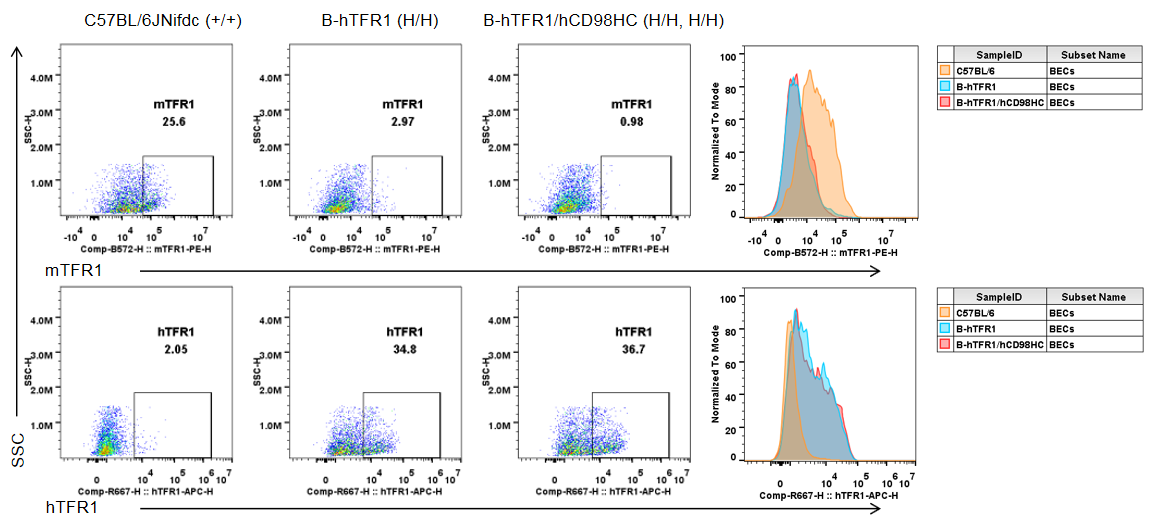
Strain specific TFR1 expression analysis in wild-type C57BL/6JNifdc and homozygous B-hTFR1/hCD98HC mice by flow cytometry. Brain cells were collected from wild-type C57BL/6JNifdc (+/+), homozygous B-hTFR1 mice (H/H) and homozygous B-hTFR1/hCD98HC mice (H/H, H/H), and analyzed by flow cytometry with anti-mouse TFR1 antibody (Biolegend, 113808) and anti-human TFR1 antibody (Biolegend, 334108). mTFR1 was only detectable in brain endothelial cells in wild-type mice, and hTFR1 was exclusively detectable in homozygous B-hTFR1 mice and B-hTFR1/hCD98HC mice but not in wild-type mice.
Protein expression analysis of CD98HC in blood leukocytes

Strain specific CD98HC expression analysis in wild-type C57BL/6JNifdc and homozygous B-hTFR1/hCD98HC mice by flow cytometry. Blood cells were collected from wild-type C57BL/6JNifdc (+/+) and homozygous B-hTFR1/hCD98HC mice (H/H, H/H) and analyzed by flow cytometry with anti-mouse CD98HC antibody (Biolegend, 128211) and anti-human CD98HC antibody (231161-CD98BBBB-h1.L produced in-house). mCD98HC was only detectable in wild-type mice, and hCD98HC was exclusively detectable in homozygous mice but not in wild-type mice.
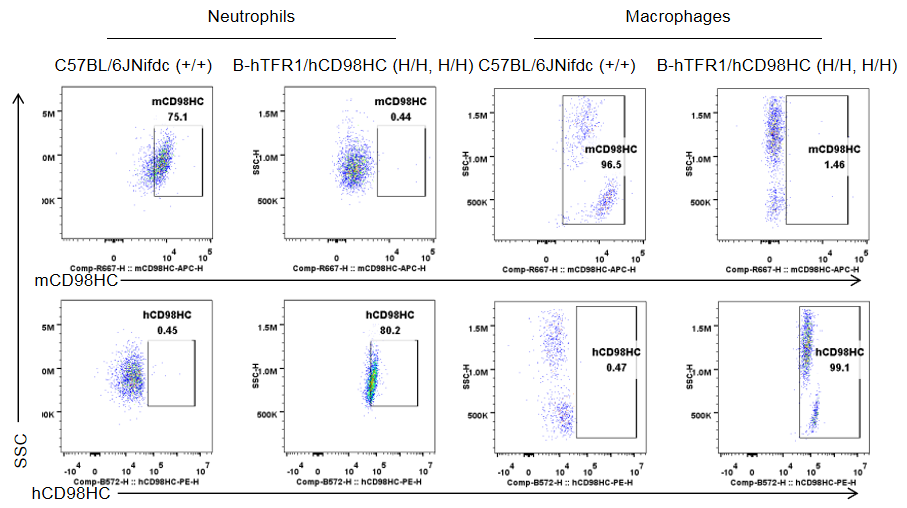
Strain specific CD98HC expression analysis in wild-type C57BL/6JNifdc and homozygous B-hTFR1/hCD98HC mice by flow cytometry. Blood cells were collected from wild-type C57BL/6JNifdc (+/+) and homozygous B-hTFR1/hCD98HC mice (H/H, H/H) and analyzed by flow cytometry with anti-mouse CD98HC antibody (Biolegend, 128211) and anti-human CD98HC antibody (231161-CD98BBBB-h1.L produced in-house). mCD98HC was only detectable in wild-type mice, and hCD98HC was exclusively detectable in homozygous mice but not in wild-type mice.
Protein expression analysis of CD98HC in brain endothelial cells
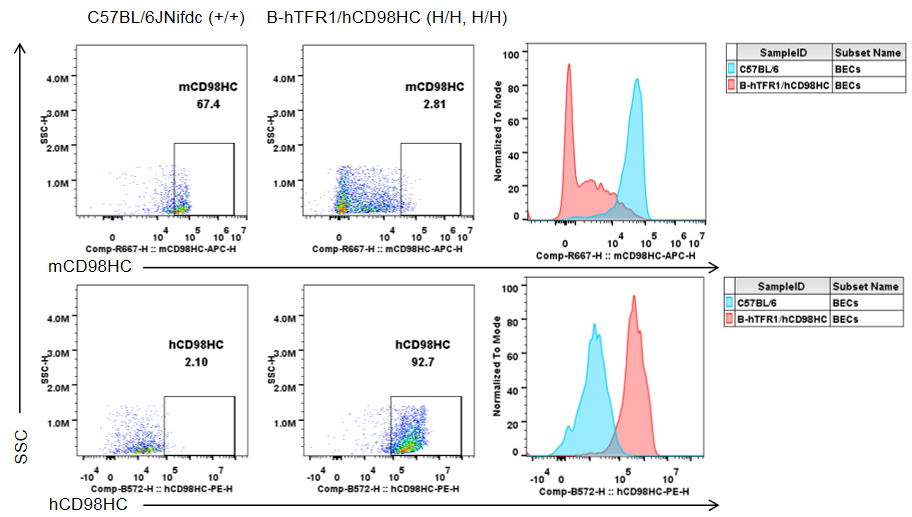
Strain specific CD98HC expression analysis in wild-type C57BL/6JNifdc and homozygous B-hTFR1/hCD98HC mice by flow cytometry. Brain cells were collected from wild-type C57BL/6JNifdc (+/+) and homozygous B-hTFR1/hCD98HC mice (H/H, H/H) and analyzed by flow cytometry with anti-mouse CD98HC antibody (Biolegend, 128211) and anti-human CD98HC antibody (231161-CD98BBBB-h1.L produced in-house). mCD98HC was only detectable in brain endothelial cells in wild-type mice, and hCD98HC was exclusively detectable in homozygous mice but not in wild-type mice.
Frequency of leukocyte subpopulations
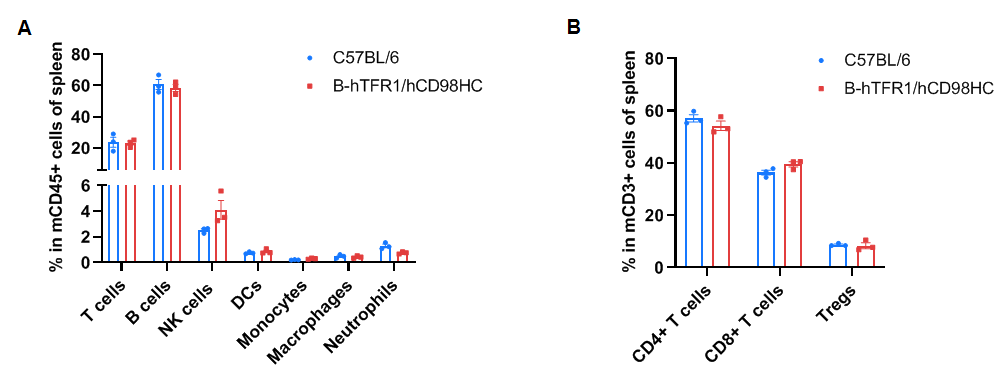
Frequency of leukocyte subpopulations in spleen by flow cytometry. Splenocytes were isolated from wild-type C57BL/6JNifdc mice (female, n=3, 7-week-old) and homozygous B-hTFR1/hCD98HC mice (female, n=3, 7-week-old). A. Flow cytometry analysis of the splenocytes was performed to assess the frequency of leukocyte subpopulations. B. Frequency of T cell subpopulations. Percentages of T cells, B cells, NK cells, DCs, neutrophils, monocytes, macrophages, CD4+ T cells, CD8+ T cells and Tregs in B-hTFR1/hCD98HC mice were similar to those in C57BL/6JNifdc mice, demonstrating that humanization of TFR1 and CD98HC does not change the frequency or distribution of these cell types in spleen. The frequency of leukocyte subpopulations in blood and lymph nodes of B-hTFR1/hCD98HC mice were also comparable to wild-type C57BL/6JNifdc mice (Data not shown). Values are expressed as mean ± SEM. Significance was determined by two-way ANOVA test. *P < 0.05, **P < 0.01, ***p < 0.001.
Homozygous TFR1 mutant embryos do not survive past E12.5, exhibiting anemia, hydrops fetalis, and neurological defects (MGI).
Homozygous CD98HC mutant mice display embryonic lethality (MGI).
In vivo PK evaluation and comparison of anti-human TFR1 and anti-CD98HC antibody

In vivo PK evaluation and comparison of anti-human TFR1 and anti-CD98HC antibody. B-hTFR1/hCD98HC mice (n=2, female, 8-week-old) were injected with control IgG (10 mpk) anti-human TFR1 antibody (JR-141 analog, monovalent, produced in house, 12.56 mpk) and anti-human CD98HC antibody (CD98BBBB-h1.L analog, monovalent, produced in house, 13.3 mpk) via tail vein. Brain were taken for in vivo PK evaluation. Brain concentrations (A) and % of injection/gram brain (B) were quantified. As shown in panel, anti-human TFR1 antibody exhibited higher brain exposure in 24 h after dose, while anti-CD98HC antibody exhibited higher brain exposure in 72 h after dose. The results confirmed that B-hTFR1/hCD98HC mice enables uptake of an intravenously administered anti-human TFR1 antibody or anti-human CD98HC antibody, and this mice can be used for the comparison of penetration efficacy of shuttle molecules targeting TFR1 or CD98HC. Graphs represent mean ± SEM.
















